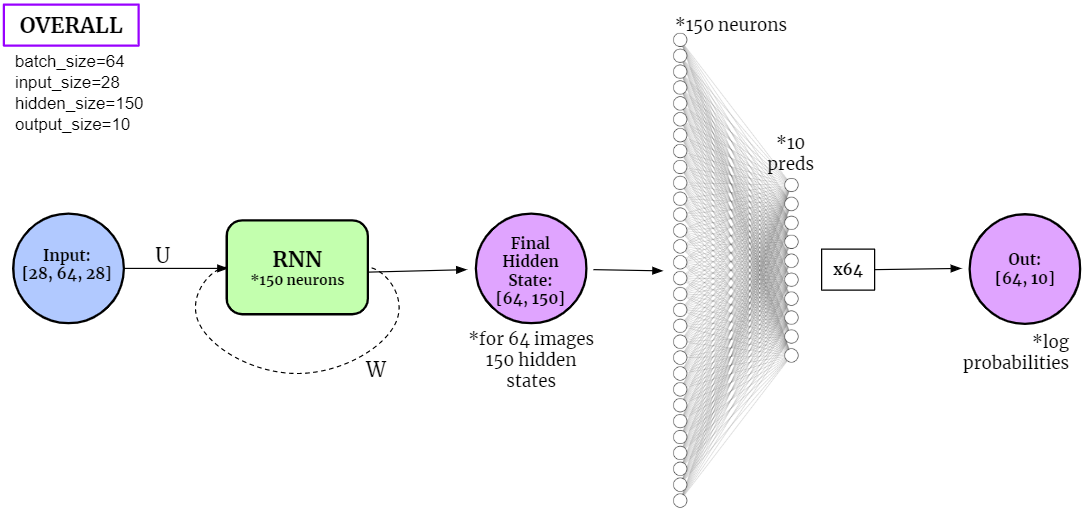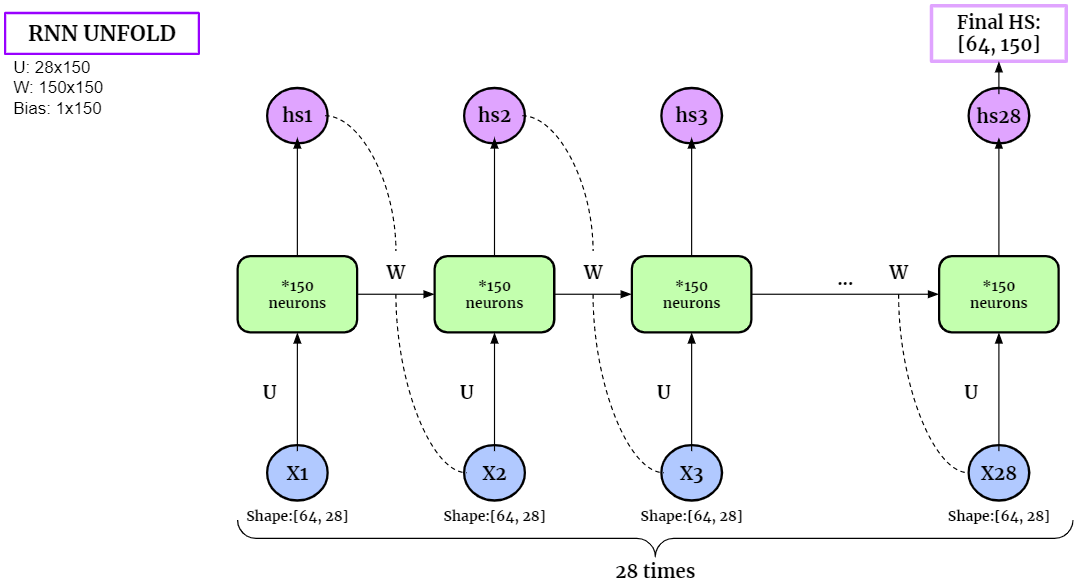Training Single-Layer RNN with Constrained Weights#
Recurrent Neural Networks are very different from FNNs or CNNs.
RNNs model sequential data, meaning they have sequential memory. An RNN takes in different kind of inputs (text, words, letters, parts of an image, sounds, etc.) and returns different kinds of outputs (the next word/letter in the sequence, paired with an FNN it can return a classification etc.). Here is an example for a RNN with 1 layer.

How RNN works:
It uses previous information to affect later ones
There are 3 layers: Input, Output and Hidden (where the information is stored)
The loop: passes the input forward sequentialy, while retaining information about it
This info is stored in the hidden state
There are only 3 matrixes (U, V, W) that contain weights as parameters. These DON’T change with the input, they stay the same through the entire sequence.
When applied to the classification tasks on MNIST dataset, the structure of the neural network becomes

If we unfold the RNN layers, it becomes

# Imports
import torch
import torch.nn as nn
import torch.nn.functional as F
import torch.optim as optim
import os
import numpy as np
import torchvision
import torchvision.transforms as transforms
import matplotlib.pyplot as plt
%matplotlib inline
import sklearn.metrics
import seaborn as sns
import random
from torch.nn.parameter import Parameter
# To display youtube videos
from IPython.display import YouTubeVideo
import cdopt
from cdopt.manifold_torch import euclidean_torch, stiefel_torch
from cdopt.nn import RNN_cdopt, get_quad_penalty
def set_seed(seed = 1234):
'''Sets the seed of the entire notebook so results are the same every time we run.
This is for REPRODUCIBILITY.'''
np.random.seed(seed)
random.seed(seed)
torch.manual_seed(seed)
torch.cuda.manual_seed(seed)
# When running on the CuDNN backend, two further options must be set
torch.backends.cudnn.deterministic = True
# Set a fixed value for the hash seed
os.environ['PYTHONHASHSEED'] = str(seed)
set_seed()
device = torch.device('cuda' if torch.cuda.is_available() else 'cpu')
# device = torch.device('cpu')
print('Device available now:', device)
Device available now: cuda
Define the network#
Define a neurnal with constrained weights are quite simple via CDOpt, we only need the following two procedures:
Replace the layers in
torch.nnby the layers fromcdopt.utils_torch.nnand specify themanifold_classoptions.Add the
layer.quad_penalty()to the loss function.
# The Neural Network
class VanillaRNN_MNIST(nn.Module):
def __init__(self, batch_size, input_size, hidden_size, output_size):
super(VanillaRNN_MNIST, self).__init__()
self.batch_size, self.input_size, self.hidden_size, self.output_size = batch_size, input_size, hidden_size, output_size
# replace nn.RNN Layer by the layers from `cdopt.nn.RNN_cdopt`. Users can try other manifold classes from `cdopt.manifold_torch`
self.rnn = RNN_cdopt(input_size, hidden_size, manifold_class = stiefel_torch, penalty_param = 0.2)
# Fully Connected Layer. Users can try other manifold classes from `cdopt.manifold_torch`.
self.layer = nn.Linear(hidden_size, self.output_size)
# self.layer = cdopt.nn.Linear_cdopt(hidden_size, self.output_size, manifold_class= stiefel_torch)
def forward(self, images, prints=False):
if prints: print('Original Images Shape:', images.shape)
images = images.permute(1, 0, 2)
if prints: print('Permuted Imaged Shape:', images.shape)
# Initialize hidden state with zeros
hidden_state = torch.zeros(1, self.batch_size, self.hidden_size, device = device)
if prints: print('Initial hidden state Shape:', hidden_state.shape)
# Creating RNN
hidden_outputs, hidden_state = self.rnn(images, hidden_state)
# Log probabilities
out = self.layer(hidden_state)
if prints:
print('----hidden_outputs shape:', hidden_outputs.shape, '\n' +
'----final hidden state:', hidden_state.shape, '\n' +
'----out shape:', out.shape)
# Reshaped out
out = out.view(-1, self.output_size)
if prints: print('Out Final Shape:', out.shape)
return out
Training RNN#
We’ll use
get_accuracy()andtrain_network()functions from the examples on Kaggle, but with some changes (suited to the RNN’s needs).
# Customized transform (transforms to tensor, here you can normalize, perform Data Augmentation etc.)
my_transform = transforms.Compose([transforms.ToTensor()])
# Download data
mnist_train = torchvision.datasets.MNIST('data', train = True, download=True, transform=my_transform)
mnist_test = torchvision.datasets.MNIST('data', train = False, download=True, transform=my_transform)
def get_accuracy(out, actual_labels, batchSize):
'''Saves the Accuracy of the batch.
Takes in the log probabilities, actual label and the batchSize (to average the score).'''
predictions = out.max(dim=1)[1]
correct = (predictions == actual_labels).sum().item()
accuracy = correct/batch_size
return accuracy
def train_network(model, train_data, test_data, batchSize=64, num_epochs=1, learning_rate=0.0005):
'''Trains the model and computes the average accuracy for train and test data.'''
print('Get data ready...')
# Create dataloader for training dataset - so we can train on multiple batches
# Shuffle after every epoch
train_loader = torch.utils.data.DataLoader(dataset=train_data, batch_size=batchSize, shuffle=True, drop_last=True)
test_loader = torch.utils.data.DataLoader(dataset=test_data, batch_size=batchSize, shuffle=True, drop_last=True)
# Create criterion and optimizer
criterion = nn.CrossEntropyLoss()
optimizer = optim.Adam(model.parameters(), lr=learning_rate)
print('Training started...')
# Train the data multiple times
for epoch in range(num_epochs):
# Save Train and Test Loss
train_loss = 0
train_acc = 0
# Set model in training mode:
model.train()
for k, (images, labels) in enumerate(train_loader):
# Get rid of the channel
images = images.view(-1, 28, 28)
images = images.to(device)
labels = labels.to(device)
# print(labels.device)
# Create log probabilities
out = model(images)
# Clears the gradients from previous iteration
optimizer.zero_grad()
# Computes loss: how far is the prediction from the actual? And add the layer.quad_penalty() to the loss function.
loss = criterion(out, labels) + get_quad_penalty(model)
# Computes gradients for neurons
loss.backward()
# Updates the weights
optimizer.step()
# Save Loss & Accuracy after each iteration
train_loss += loss.item()
train_acc += get_accuracy(out, labels, batchSize)
# Print Average Train Loss & Accuracy after each epoch
print('TRAIN | Epoch: {}/{} | Loss: {:.2f} | Accuracy: {:.2f}'.format(epoch+1, num_epochs, train_loss/k, train_acc/k))
print('Testing Started...')
# Save Test Accuracy
test_acc = 0
# Evaluation mode
model.eval()
for k, (images, labels) in enumerate(test_loader):
# Get rid of the channel
images = images.view(-1, 28, 28)
images = images.to(device)
labels = labels.to(device)
# Create logit predictions
out = model(images)
# Add Accuracy of this batch
test_acc += get_accuracy(out, labels, batchSize)
# Print Final Test Accuracy
print('TEST | Average Accuracy per {} Loaders: {:.5f}'.format(k, test_acc/k) )
# ==== STATICS ====
batch_size=64
input_size=28
hidden_size=150
output_size=10
# Instantiate the model
vanilla_rnn = VanillaRNN_MNIST(batch_size, input_size, hidden_size, output_size)
vanilla_rnn.to(device)
VanillaRNN_MNIST(
(rnn): RNN_cdopt(28, 150)
(layer): Linear(in_features=150, out_features=10, bias=True)
)
# ==== TRAIN ====
train_network(vanilla_rnn, mnist_train, mnist_test, num_epochs=10)
Get data ready...
Training started...
TRAIN | Epoch: 1/10 | Loss: 0.86 | Accuracy: 0.79
TRAIN | Epoch: 2/10 | Loss: 0.41 | Accuracy: 0.89
TRAIN | Epoch: 3/10 | Loss: 0.30 | Accuracy: 0.92
TRAIN | Epoch: 4/10 | Loss: 0.25 | Accuracy: 0.93
TRAIN | Epoch: 5/10 | Loss: 0.22 | Accuracy: 0.94
TRAIN | Epoch: 6/10 | Loss: 0.20 | Accuracy: 0.95
TRAIN | Epoch: 7/10 | Loss: 0.18 | Accuracy: 0.95
TRAIN | Epoch: 8/10 | Loss: 0.17 | Accuracy: 0.95
TRAIN | Epoch: 9/10 | Loss: 0.15 | Accuracy: 0.96
TRAIN | Epoch: 10/10 | Loss: 0.15 | Accuracy: 0.96
Testing Started...
TEST | Average Accuracy per 155 Loaders: 0.96522
vanilla_rnn.rnn.quad_penalty()
tensor(0.0035, device='cuda:0', grad_fn=<AddBackward0>)
Reference#
https://www.kaggle.com/code/andradaolteanu/pytorch-rnns-and-lstms-explained-acc-0-99
Jing L, Gulcehre C, Peurifoy J, et al. Gated orthogonal recurrent units: On learning to forget[J]. Neural computation, 2019, 31(4): 765-783.
Hu X, Xiao N, Liu X, Toh KC. A Constraint Dissolving Approach for Nonsmooth Optimization over the Stiefel Manifold[J]. arXiv preprint arXiv:2205.10500, 2022.